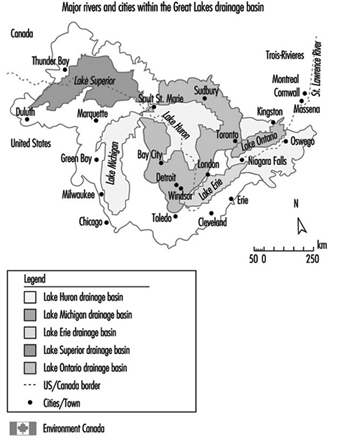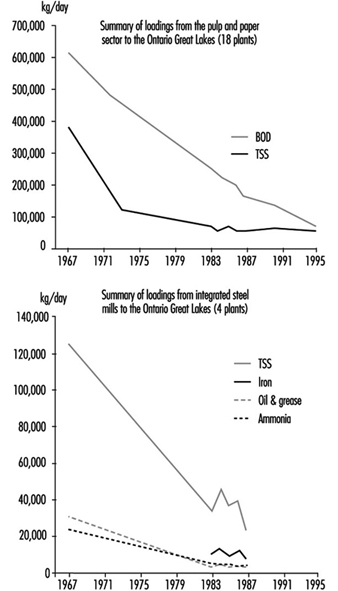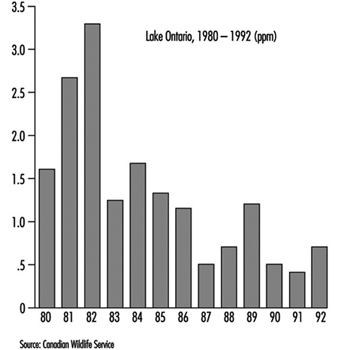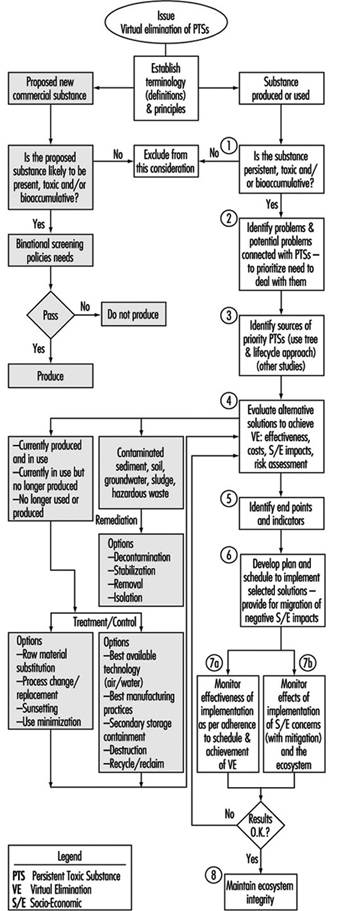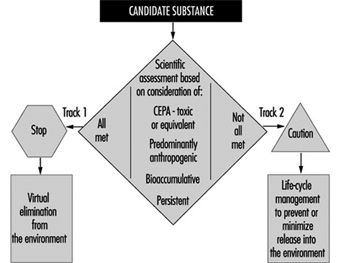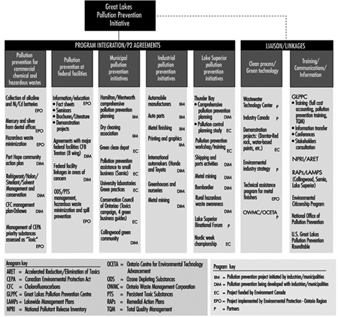The Challenge
The Great Lakes are a shared resource between Canada and the United States (see figure 1). The five large lakes contain over 18% of the world’s surface water. The basin is home to one in every three Canadians (approximately 8.5 million ) and one in every nine Americans (27.5 million). The basin is the industrial heartland of both countries - one-fifth of the US industrial base and one-half of Canada’s. Economic activities around the Great Lakes basin generate an estimated 1 trillion dollars of wealth each year. Over time, increasing population and industrial activities created a variety of stresses on the lakes until the need for concerted action to protect the Great Lakes by the two countries was recognized in mid-century.
Figure 1. Great Lakes drainage basin: St. Lawrence River
The Response
Since the 1950s, both countries have put in place domestic and bilateral programmes to address gross pollution problems and also to respond to more subtle water quality concerns. As a result of these actions, Great Lakes waters are visibly cleaner than they were at mid-century, loadings of heavy metals and organic chemicals have decreased and contaminant levels in fish and aquatic birds have gone down significantly. The successes of Canada–United States actions to restore and protect the Great Lakes provide a model for bilateral cooperation on resource management, but challenges remain.
The Case Study in Perspective
The threats posed by persistent toxic substances, however, are long term in nature and their management requires a multimedia, comprehensive at-source approach. To achieve a long-term goal of virtual elimination of persistent toxic substances from the Great Lakes, environmental authorities, industries and other stakeholders in the basin were challenged to develop new approaches and programmes. The purpose of this case study report is to provide a brief summary of Canadian pollution control programmes and the progress achieved by 1995, and to outline initiatives for managing persistent toxics in the Great Lakes. Similar US initiatives and programmes are not discussed herein. Interested readers should contact the Great Lakes National Program Office of the US Environmental Protection Agency in Chicago for information on federal and state programmes for protecting the Great Lakes.
1970s–1980s
A significant problem acknowledged to be affecting Lake Erie in the 1960s was nutrient enrichment or eutrophication. The identified need for bilateral actions prompted Canada and the United States to sign the first Great Lakes Water Quality Agreement (GLWQA) in 1972. The Agreement outlined abatement goals for reducing phosphorus loadings primarily from laundry detergents and municipal sewage effluent. In response to this commitment Canada and Ontario enacted legislation and programmes for controlling point sources. Between 1972 and 1987, Canada and Ontario invested more than 2 billion dollars in sewage treatment plant construction and upgrading in the Great Lakes basin.
Figure 2. Progress on industrial abatement
The 1972 GLWQA also identified the need to reduce releases of toxic chemicals into the lakes from industries and other sources such as spills. In Canada, the promulgation of federal effluent (end of pipe) regulations in the 1970s for conventional pollutants from major industrial sectors (pulp and paper, metal mining, petroleum refining and so on) provided a national baseline standard, while Ontario established similar effluent guidelines tailored for local needs including the Great Lakes. Actions by industries and municipalities to meet these federal and Ontario effluent requirements produced impressive results; for example, phosphorus loadings from point sources to Lake Erie were reduced by 70% between 1975 and 1989, and discharges of conventional pollutants from the seven Ontario petroleum refineries were cut by 90% since the early 1970s. Figure 2 shows similar loading reduction trends for the pulp and paper and the iron and steel sectors.
By the mid-1970s evidence of elevated concentrations of toxic chemicals in Great Lakes fish and wildlife, reproductive abnormalities in some fish-eating birds and population decline in a number of species implicated persistent bioaccumulative toxic substances, which became the new focus for the binational protection effort. Canada and the United States signed a second Great Lakes Water Quality Agreement in 1978, in which the two countries pledged to “restore and maintain the chemical, physical and biological integrity of the waters of the Great Lakes Ecosystem”. A key challenge was the policy “that the discharge of toxic substances in toxic amounts be prohibited and the discharge of any or all persistent toxic substances be virtually eliminated”. The call for virtual elimination was necessary, as persistent toxic chemicals may concentrate and accumulate in the food chain, causing severe and irreversible damages to the ecosystem, whereas chemicals which are not persistent needed to be kept below levels which cause immediate harm.
In addition to tighter controls on point sources, Canada and Ontario developed and/or strengthened controls on pesticides, commercial chemicals, hazardous wastes and non-point sources of pollution such as dump sites and incinerators. Government initiatives became more multimedia oriented, and the concept of “cradle to grave” or “responsible care” for chemicals became the new environmental management philosophy for government and industries alike. A number of persistent toxic pesticides were banned under the federal Pest Control Products Act (DDT, Aldrin, Mirex, Toxaphene, Chlordane) and the Environmental Contaminants Act was used to (1) prohibit commercial, manufacturing and processing uses of persistent toxics (CFC, PPB, PCB, PPT, Mirex, lead) and (2) to limit chemical releases from specific industrial operations (mercury, vinyl chloride, asbestos).
By the early 1980s, results from these programmes and measures and similar American efforts started producing evidence of a rebound. Contaminant levels in Great Lakes sediments, fish and wildlife were on the decline, and noted environmental improvements included the return of bald eagles to the Canadian shore of Lake Erie, a 200-fold increase in cormorant population, a resurgence in osprey on Georgian Bay and the re-establishment in the Toronto Harbour area of common terns - all have been affected by levels of persistent toxic substances in the past, and their recovery illustrates the success of this approach to date.
Figure 3. Mirex in herring gull eggs
The trend toward reduced concentrations for some of the persistent toxic substances in fish, wildlife and sediments levelled off by the mid-1980s (see Mirex in herring gull eggs in figure 3). It was concluded by scientists that:
- While the water pollution and contaminants control programmes in place were helpful, they were not enough to bring about further reductions in contaminant concentrations.
- Additional measures were required for non-point sources of persistent toxics including contaminated sediments, long range atmospheric input of pollutants, abandoned dump sites and so on.
- Some pollutants can persist in the ecosystem at minute concentrations and can bioaccumulate in the food chain for a long time.
- The most efficient and effective approach for dealing with persistent toxics is to prevent or eliminate their generation at source rather than virtually eliminate their release.
It was generally agreed that achieving virtual elimination in the environment through the application of zero-discharge philosophy to sources and the ecosystem approach to Great Lakes water quality management needed to be further strengthened and promoted.
To reaffirm their commitment to the virtual elimination goal for persistent toxic substances, Canada and the United States amended the 1978 Agreement through a protocol in November 1987 (United States and Canada 1987). The protocol designated areas of concern where beneficial uses have been impaired around the Great Lakes, and required the development and implementation of remedial action plans (RAPs) for both point and non-point sources in the designated areas. The protocol also stipulated lakewide management plans (LAMPs) to be used as the main framework for resolving whole-lake impairment of beneficial uses and for coordinating control of persistent toxic substances impacting each of the Great Lakes. Furthermore, the protocol included new annexes for establishing programmes and measures for airborne sources, contaminated sediments and dump sites, spills and control of exotic species.
1990s
Following the signing of the 1987 protocol, the goal of virtual elimination was strongly promoted by environmental interest groups on both sides of the Great Lakes as concerns about the threat of persistent toxics increased. The International Joint Commission (IJC), the binational advisory body created under the 1909 Boundary Waters Treaty, also strongly advocated the virtual elimination approach. An IJC binational task force recommended a strategy for Virtual Elimination in 1993 (see figure 4). By the mid-1990s, the IJC and the parties are attempting to define a process for implementing this strategy, including considerations for socioeconomic impacts.
Figure 4. Decision-making process for virtual elimination of persistent toxic substances from the Great Lakes
The governments of Canada and Ontario responded in a number of ways to control or reduce the release of persistent toxics. The important programmes and initiatives are briefly summarized below.
Canadian Environmental Protection Act (CEPA)
In 1989, Environment Canada consolidated and streamlined its legal mandates into a single statute. CEPA provides the federal government with comprehensive powers (e.g., information gathering, regulations making, enforcement) over the entire life cycle of chemicals. Under CEPA, the New Substances Notification Regulations establish screening procedures for new chemicals so that persistent toxics that cannot be adequately controlled will be prohibited from being imported, manufactured or used in Canada. The first phase of the Priority Substances List (PSL I) assessment programme was completed in 1994; 25 of the 44 substances assessed were found to be toxic under the definition of CEPA, and the development of management strategies for these toxic chemicals was initiated under a Strategic Options Process (SOP); an additional 56 priority substances will be nominated and assessed in phase II of the PSL programme by the year 2000. The National Pollutant Release Inventory (NPRI) was implemented in 1994 to mandate industrial and other facilities that meet the reporting criteria to annually report their releases to air, water and land, and their transfers in waste, of 178 specified substances. The inventory, modelled on the Toxic Release Inventory (TRI) in the United States, provides an important database for prioritizing pollution prevention and abatement programmes.
Canada-Ontario Agreement (COA)
In 1994, Canada and Ontario set out a strategic framework for coordinated action to restore, protect and conserve the Great Lakes ecosystem with a key focus on reducing the use, generation or release of 13 Tier I persistent toxic substances by the year 2000 (Canada and Ontario 1994). COA also targets an additional list of 26 priority toxics (Tier II) for significant reductions. Specifically for Tier I substances, COA will: (1) confirm zero discharge of five banned pesticides (Aldrin, DDT, Chlordane, Mirex, Toxaphene); (2) seek to decommission 90% of high-level PCBs, destroy 50% now in storage and accelerate destruction of low-level PCBs in storage; and (3) seek 90% reduction in the release of the remaining seven Tier I substances (benzo(a)pyrene, hexachlorobenzene, alkyl-lead, octachlorostyrene, PCDD (dioxins) PCDF (furans) and mercury).
The COA approach is to seek quantitative reductions wherever feasible, and sources are challenged to apply pollution prevention and other means to meet the COA targets. Fourteen projects have already been launched by federal Ontario staff to achieve reduction/elimination of Tiers I and II substances.
Toxic Substances Management Policy
In recognition of the need for a preventive and precautionary approach, Environment Canada announced in June 1995 a national Toxic Substances Management Policy as the framework for efficient management of toxic substances in Canada (Environment Canada 1995a). The policy adopts a two-track approach (see figure 5) that recognizes management actions must be tailored to the characteristics of chemicals; that is:
- to virtually eliminate from the environment substances that are predominantly anthropogenic, persistent, bioaccumulative and toxic (Track I)
- to implement full life cycle (cradle-to-grave) management of all other substances of concern (Track II).
Figure 5. Selection of management objectives under the Toxic Substances Management Policy
A set of scientifically based criteria (Environment Canada 1995b) (see table 1) will be used to categorize substances of concern into the two tracks. If a substance identified for either track is not adequately controlled under existing programmes, additional measures will be identified under the multi-stakeholder Strategic Options Process. The policy is consistent with the Great Lakes Water Quality Agreement and will direct and frame a number of domestic programmes by defining their ultimate environmental objective, but the means and pace of achieving the ultimate objective will vary by chemical and source. Further, Canada’s position on persistent toxics will also be framed by this policy in international discussions.
Table 1. Criteria for the selection of substances for Track 1 toxic substances management policy
|
Persistence |
Bioaccumulation |
Toxicity |
Predominantly Anthropogenic |
|
|
Medium |
Half-life |
|||
|
Air |
≥2 days |
BAF≥5,000 |
CEPA-toxic |
Concentration |
Chlorine Action Plan
A comprehensive approach to managing chlorinated substances within the context of the Toxic Substances Management Policy was announced in October 1994 by Environment Canada (Environment Canada 1994). The approach will be to prune the chlorine-use tree with a five-part action plan that will (1) target action on critical uses and products, (2) improve scientific understanding of chlorine and its impact on health and the environment, (3) detail socioeconomic implications, (4) improve public access to information and (5) promote international actions on chlorinated substances. Chlorine use has already decreased in Canada in recent years, for example by 45% in the pulp and paper sector since 1988. Implementation of the Chlorine Action Plan will accelerate this reduction trend.
Great Lakes Pollution Prevention Initiative
A strong pollution prevention programme has been put in place for the Great Lakes basin. Since March 1991, Environment Canada and the Ontario Ministry of the Environment and Energy have been working together with industries and other stakeholders to develop and implement pollution prevention projects, in contrast to waste treatment or reducing pollution after its generation. In 1995/96, more than 50 projects will cover commercial chemicals, hazardous waste management, federal facilities, industries, municipalities and the Lake Superior basin. Figure 6 provides an overview of these projects, which fall into two main categories: programme integration or voluntary agreements. The figure also shows programme linkages with other programmes discussed earlier (NPRI, RAP, LAMP) and a number of institutions that work with Environment Canada closely on green technologies and clean processes, as well as on training, information and communications. Pollution prevention projects can produce impressive results, as evidenced by the Automotive Manufacturers, who have undertaken 15 pilot projects recently, thereby reducing or eliminating 2.24 million kilograms of targeted substances from the manufacture of automobiles at the Ontario facilities of Chrysler, Ford and General Motors.
Figure 6. Great Lakes pollution prevention
Accelerated Reduction/Elimination of Toxics (ARET)
ARET is a cooperative multi-stakeholder initiative launched in 1994 that seeks the eventual elimination of 14 priority toxics with an interim target (by the year 2000) of a 90% reduction/elimination and reduced emission (50%) of 87 less harmful toxic substances (ARET Secretariat 1995). As of 1995, more than 200 companies and government agencies are participating in this voluntary initiative. Together, they reduced emissions by 10,300 tonnes in comparison with the 1988 base year and are committed to an additional 8,500 tonnes reduction by the year 2000.
Binational and international strategies
In addition to the above domestic initiatives, Canada and the United States are currently developing a binational strategy to coordinate agency action and to establish shared goals for persistent toxics in the Great Lakes basin. Goals and objectives similar to the Canada-Ontario Agreement for the Tiers I and II substances and a similar US list will be adopted. Joint projects will be developed and implemented to facilitate information exchange and agency action on priority chemicals such as PCBs and mercury. By taking an aggressive approach to virtual elimination as outlined above, Canada will be able to assume a leadership role in promoting international action on persistent toxics. Canada hosted a United Nations conference in June 1995 in Vancouver to focus global dialogue on persistent organic pollutants (POP) and to explore pollution prevention approaches to reducing their emissions around the world. Canada also co-chairs the United Nations Economic Commission for Europe (UNECE) workgroup to develop a protocol for persistent organic pollutants under the Convention on Long Range Transboundary Air Pollution.
An Example—Dioxins and Furans
For more than a decade, polychlorinated dibenzo-dioxins and furans have been recognized as a group of persistent toxics of concern to the Canadian environment and the Great Lakes. Table 2 summarizes federal actions and the reductions in releases achieved to date, illustrating the mix of programmes and initiatives which has resulted in significant reductions of these toxics. In spite of these impressive results, dioxins and furans will remain priorities under the Toxic Substances Management Policy, the Chlorine Action Plan, the Canada Ontario Agreement and the binational strategy outlined above, because virtual elimination requires further reductions.
Table 2. Summary of reductions in releases of dioxin and furan in Canada
|
Sources of Emissions |
Reductions |
Reporting Period |
Canadian Government Initiatives |
|
Bleached kraft pulpmill effluents |
82% |
1989-94 |
CEPA defoamer, wood chip and |
|
2,4,5-T—pesticide |
100% |
1985 |
Banned from use under PCPA |
|
2,4-D—pesticide |
100% |
1987-90 |
Dioxin content and use heavily |
|
Pentachlorophenol |
|
|
|
|
PCBs |
23% |
1984-93 |
CCME PCB Action Plan |
|
Incineration |
|
|
|
CCME: Canadian Council of Environmental Ministers; CEPA: Canadian Environmental Protection Act; PCPA: Pest Control Products Act.
Summary
There has been a significant improvement in the water quality of the Great Lakes as a result of pollution control actions taken by governments and stakeholders in Canada and the United States since the early 1970s. This case study report provides a summary of the Canadian effort and successes in dealing with gross pollution and conventional pollutants. It also outlines the evolution of a new approach (the Toxic Substances Management Policy, the Chlorine Action Plan, pollution prevention, voluntary action, stakeholder consultations and so on) for dealing with the much more difficult problems with persistent toxic substances in the Great Lakes. Comprehensive programmes (COA, NPRI, SOP, PSL and so on) that are being put in place with the aim of achieving the virtual elimination goal are briefly described. Details of the Canadian approach are contained in the listed references.

